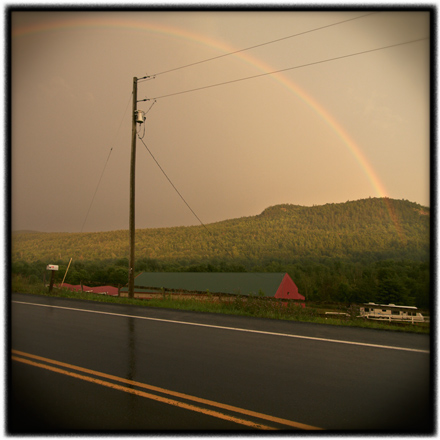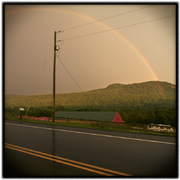man & nature # 19 ~ imagine that
 Friday, July 25, 2008 at 08:39AM
Friday, July 25, 2008 at 08:39AM 
 Rainbow in light rain • click to embiggenOnce again, the ever popular question, "How can I make better pictures?", has come to the forefront on a couple blogs / websites. Most notably so on Craig Tanner's Radiant Vista whereon he has a podcast, Finding the Heart of Your Work. The podcast is a somewhat delayed response to Joe Reifer's Going deeper may require more abstract excursions entry of May 22nd.
Rainbow in light rain • click to embiggenOnce again, the ever popular question, "How can I make better pictures?", has come to the forefront on a couple blogs / websites. Most notably so on Craig Tanner's Radiant Vista whereon he has a podcast, Finding the Heart of Your Work. The podcast is a somewhat delayed response to Joe Reifer's Going deeper may require more abstract excursions entry of May 22nd.
These two ruminations are seemingly related to part of the standard online forum mission statements which claim to answer the questions posited by means of having your picture(s) critiqued on their forums. Unfortunately, the critiques thereon are almost exclusively biased towards technique and gear which is of very little help (if any) in answering the question posited by Joe Reifer regarding how to make more meaningful pictures.
What most on these critique forums fail to realize is that there really isn't any easily canned prescribable dictumm for making meaningful pictures. The fact is, it is totally dependent upon the type of person you are. Things like, but not limited to; are you curious? are you aware? are you empathetic? are you interested in figuring things out? are you capable of seeing things anew?
Instead of thinking about gear and technique, think about this:
The greatest thing a human soul ever does in this world is to SEE something, and tell what it SAW in a plain way... To see clearly is poetry, prophecy, and religion, all in one. - John Ruskin
I agree whole heartedly with this idea and, IMO, the key to making meaningful pictures is expressed in the phrase, "tell what it SAW in a plain way". Too many people with cameras are too wrapped up in trying to make pictures that look like ... well ... pictures. By that I mean, they are trying to make pictures that look like what they have been told - either by online critique-ers, how-to books, or even well intended gurus - are good pictures. If they succeed in accomplishing that goal all they make are an endless stream of look-a-like homages to what they have seen before.
IMO, a good pictures doesn't look like a picture. It looks like what I see or, more accurately, when viewing the work of others, what they saw. It simply looks like seeing. The more closely related to plain seeing, the better. As many have opined, the best Art most often has the appearance of being effortlessly made.
Plain seeing draws attention only to the visual referent (the subject), not the photographer and by so doing, plain seeing helps the viewer establish an easier connection to the connoted (the implied, or, if you will, the meaning). To wit, the illustration does not get in the way of illumination.
And, consider this, with its intrinsic characteristic as an inimitable cohort with the real, no other visual medium can see as plainly as the medium of photography. Imagine that. What a coincidence.

Reader Comments (4)
Craig Tanner rips the heart out of pictures that people are fool enough to send him. In a perfect world, he'd be starved for blood.
Whilst I tend to agree, I think there is also a potential pitfall. If the plainly shown is the best way to draw connection to an underlying message, does one not run the risk of looking for meaning in every plain photo? Do we not then run the risk of convolving snapshots into art because they are plainly showing the subject, even if devoid of deeper meaning? Doesn't that just turn us into members of the lunatic fringe?
What I'm getting at is when does a plainly shown subject rise beyond the everyday? How does one tell?
Ruskin is not talking about "plain seeing", but rather plain retelling of what one saw. It is an important distinction because there is nothing plain about seeing for Ruskin; he says 'see clearly' which is a skill he feels few possess. Consider that throughout Modern Painters (from where this quote is taken) Ruskin is championing Turner's work for its breathtaking and active 'seeing' of nature. The 'seeing' is anything but plain. It is precise, clear, cutting, and above all engaged with the world. This would discount snapshots which demonstrate very little active seeing; if one doesn't see anything in the first place, there is little to point to saying it plainly. Ruskin is often ranting against style without content, while a snapshot is generally a work lacking both style and content.
Ruskin, and this passage in particular, is interesting in the context of this journal because he is so clearly against over-thinking and philosophizing when it comes to art and literature. In the next breath after the passage quoted above, Ruskin goes on to say:
Where does that leave someone like Roland Barthes? John Ruskin, although always fascinating, can be frustrating. How can we speak precisely about art or literature without at some point delving into aesthetics or metaphysics? I imagine Ruskin's answer would be speaking precisely about art is not something a true artist should concern himself with--leave that to the critics and go about your business of seeing and creating.
Um, sadly, "plain seeing" may draw attention to the referent, not to the artist, but it makes crap art. Turn with me now to plate 15, from "Cape Light" by Joel Meyerowitz. It's a swimming pool, some chairs, a beach umbrella, and the horizon. Pretty darn plain, if you ask me. Anybody REALLY think the average photographer would take a photograph as beautiful as this of this scene? Anybody think the hand of the artist isn't visible? Anybody really think "the referent" is all that matters here?